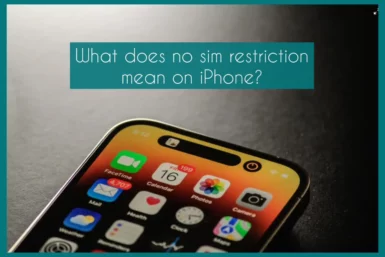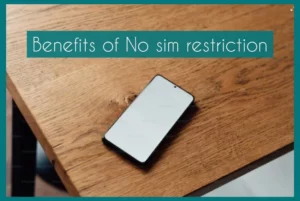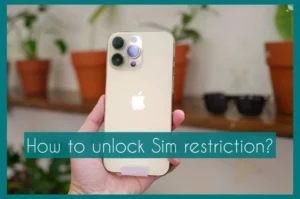Have you ever wondered what it means when an iPhone is said to have “No SIM Restriction”? This means the independence of using your iPhone without being restricted to a certain carrier or SIM card.
In this article, we’ll go into the meaning and importance of this feature, looking at how it enables customers to switch between providers and have a more flexible mobile experience.
Why does iPhone say SIM Restricted?
When an iPhone is limited to a certain carrier or network, the message “SIM Restricted” usually appears. This limitation may be due to several factors, such as agreements between the carrier and the phone manufacturer, unpaid balances, or purchases of discounted phones.
When an iPhone is SIM-restricted, it means that only SIM cards from the chosen carrier are allowed to be used, which restricts the user’s ability to change networks.
One frequently needs to complete contractual requirements, pay back debts, or contact the carrier to seek an unlock to eliminate this restriction.
Understanding why an iPhone shows this notification highlights the intricate interactions between mobile devices and carriers.
What Do No Sim Restrictions Mean on iPhone?
An iPhone with “No SIM Restrictions” is not locked to a particular carrier or network. This essentially means that you are free to use your iPhone with SIM cards from other carriers.
A phone without these restrictions can be readily switched between different carriers by inserting their respective SIM cards, unlike a SIM-restricted iPhone, which only functions with a certain carrier’s SIM card.
By giving users more freedom, this feature enables them to benefit from improved plans, coverage, and pricing options. A “No SIM Restrictions” iPhone allows you to personalize your mobile experience without being restricted by carrier restrictions.
How Can You Know if Your iPhone Has Sim Restrictions?
You can take a few measures to determine if your iPhone has SIM restrictions. Insert the SIM card from any different carrier first, if possible. The phone probably has SIM restrictions if it displays an error message or asks for an unlock code.
To find out if there are any restrictions on using other SIM cards, you can also contact your existing provider. Searching for carrier-specific information in the iPhone’s settings is another option.
The iPhone may be limited until the contract’s conditions are fulfilled, or if you bought the device directly from a carrier at a discounted price, any outstanding balances are paid.
If unsure, you may discover whether your iPhone is SIM-restricted by contacting Apple support or your carrier.
Benefits of No SIM Restrictions iPhones
No SIM Restrictions iPhones provide a range of benefits that improve user flexibility and convenience. The main benefit is the freedom to freely switch between other carriers by exchanging SIM cards. This opens a wide range of options, better coverage, and affordable prices.
In addition, traveling abroad is made hassle-free because using a local SIM card for economical roaming is simple. Due to their appeal to a wider market, such iPhones also have a higher resale value.
Users can benefit from faster network changes without requiring carrier clearance of unlocking codes.
Ultimately, a No SIM Restrictions iPhone gives customers more control over their mobile experience, making it a flexible and useful option for individuals looking for an unhindered and seamless connection.
How to Unlock Your SIM Restrictions on iPhone if it’s Locked by Carrier?
You can have more freedom and flexibility by removing the SIM constraints on your iPhone, allowing you to fully explore your alternatives in the mobile market.
The procedures below will assist you in unlocking your phone.
1. Speak with Your Carrier
The first step in unlocking SIM constraints on your carrier-locked iPhone is to speak with the customer service department of your current carrier.
They can help you through the procedure and give you precise and appropriate guidelines for your circumstances. In some circumstances, carriers could have requirements that you must fulfill for them to unlock your smartphone.
2. Verify Eligibility
Before continuing, make sure you meet the prerequisites for unlocking. These can involve finishing the contract’s duration, making any unpaid balances, and keeping the gadget from being reported as stolen or lost.
The unlocking procedure can be sped up by collecting this information beforehand.
3. Provide Required Information
Carriers could request the IMEI number, a special identification code for your iPhone. You may find it by dialing *#06# or looking in the phone’s settings.
They can also need personal data to confirm your identification and the ownership of the device.
4. Await Confirmation
Carriers often need a few days to complete your request after you’ve submitted it. After that, they will notify you through email that your iPhone has been unlocked.
To finish the procedure, you might need to connect to iTunes or update the settings on your device.
5. Use Different SIM Cards
Your iPhone will no longer be limited to a single carrier after being unlocked. Now that SIM cards from various carriers can be inserted, you can select the coverage and plans that best fit your need.
This is especially helpful if traveling or switching carriers to get better pricing.
Conclusion
In conclusion, knowing iPhone SIM limits and unlocking alternatives is essential for getting the most out of your mobile device. This knowledge enables customers to make wise decisions regarding their connectivity and make the most of their gadgets, whether it’s the advantages of an iPhone with “No SIM Restrictions” or how to unlock carrier-bound devices.



